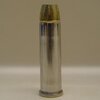buck460XVR
Member
- Joined
- Feb 6, 2007
- Messages
- 10,080
It’s better to do two even with cast, but absolutely don’t try to do both with jacketed bullets. I’ve crushed a few cases doing that after loading lots of cast, and switching to jacketed. Sometimes it will work OK. Sometimes you wind up with an explosive accordion.
When the dies are adjusted correctly, seating and crimping in one step is relatively simple and easy, especially with .38/.357. Makes complete sense on a SS, unless you are loading really heavy boomers in very long brass like the .460. If you're crushing cases with .38/.357 when seating and crimping, I guarantee you, it ain't the process.
Explosive accordion?





